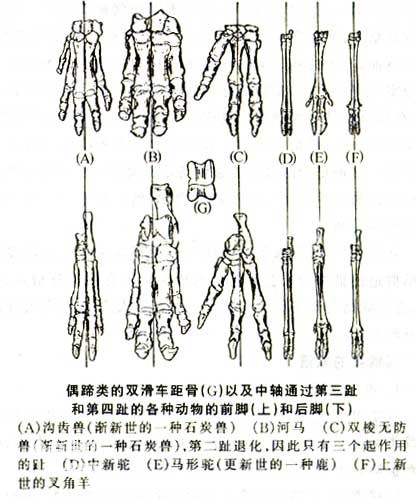In the early Eocene, a small animal called Paleoartiodactyl differentiated from the anklets. In addition to having a proximal pulley similar to that of perissodactyls, its talus also had a pulley-like distal end. It's a plane. It is this double-trochlear talus that laid the foundation for a progressive ungulate - the artiodactyls. In the years that followed, the artiodactyls differentiated into a large and diverse family divided into five major groups: Archaeodontia, Curviodontia, Suiforma, Parapoda and Ruminantia.

artiodactyl foot bones
Most modern ungulates belong to the artiodactyl class. They are named mainly because they have an even number of toes on the front and rear feet - two or four. Moreover, the central axis of the foot passes through the third and fourth toes. Between them, the weight of the body is placed on the third and fourth toes. Compared with the declining odd-dactyls, artiodactyls can be said to be particularly vibrant and prosperous, mainly due to a series of progressive traits they possess.
The talus of artiodactyls has two pulley surfaces, which allow the hind limbs to extend and bend more freely. Therefore, artiodactyls are better at jumping than odd-dactyls. In the progressive artiodactyls that appeared later, the ulna and radius of the forelimbs often healed, and the fibula of the hindlimbs often degenerated into small pieces connected to the tibia; the metacarpals and metacarpals of the third and fourth toes also often healed into cannons. bone. In addition, artiodactyls do not have the third trochanter on the lateral side of the femur like perisodactyls. These characteristics are conducive to exercise.
The success of artiodactyls is due, to a greater extent, to advances in the digestive system. On the one hand, their teeth are differentiated into a series of diverse patterns from low crown to high crown, from mound-shaped to mound-lunate to lunate, allowing different artiodactyls to adapt from omnivory to herbivory, from feeding on young leaves To feed on diverse food resources such as hard grass and hay. On the other hand, the progressive artiodactyls, the suborders Parapoda and Ruminantia, developed compartmentalized stomachs. After being cut by teeth, plant food first enters the rumen and hive stomach, where it is digested into soft pieces by symbiotic bacteria. And partially decompose, then these soft pieces are regurgitated back into the mouth, and after being fully chewed, they are re-swallowed into the omasum and abomasum to continue digestion. This complex process allows pods and ruminants to gulp down large amounts of plant food in a short period of time, then hide in a safe place to chew it slowly. In the late Cenozoic, carnivores became more effective hunters as their bodies grew larger or developed social behaviors of chasing prey in groups. At this time, the adaptability brought about by the advanced artiodactyl ruminant behavior allowed them to It can be greatly superior to odd ungulates.
animal tags: Artiodactyla
We created this article in conjunction with AI technology, then made sure it was fact-checked and edited by a Animals Top editor.